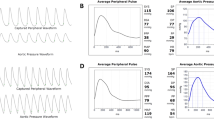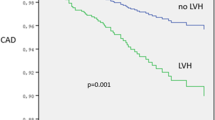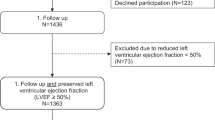Abstract
Cardiac fibrosis and high levels of circulating collagen markers has been associated with left ventricular (LV) hypertrophy. However, the relationship to vascular hypertrophy and blood pressure (BP) load is unclear. In 204 patients with essential hypertension and electrocardiographic LV hypertrophy, we measured sitting BP, serum collagen type I carboxy-terminal telopeptide (ICTP) reflecting degradation, procollagen type I carboxy-terminal propeptide (PICP) reflecting synthesis and LV mass by echocardiography after 2 weeks of placebo treatment and after 1 year of antihypertensive treatment with a losartan- or an atenolol-based regimen. Furthermore, we measured intima–media thickness of the common carotid arteries (IMT), minimal forearm vascular resistance (MFVR) by plethysmography and ambulatory 24-h BP in around half of the patients. At baseline, PICP/ICTP was positively related to IMT (r=0.24, P<0.05), MFVRmen (r=0.35, P<0.01), 24-h systolic BP (r=0.24, P<0.05) and 24-h diastolic BP (r=0.22, P<0.05), but not to LV mass. After 1 year of treatment with reduction in systolic BP (175±15 vs 151±17 mmHg, P<0.001) and diastolic BP (99±8 vs 88±9 mmHg, P<0.001), ICTP was unchanged (3.7±1.4 vs 3.8±1.4 μg/l, NS) while PICP (121±39 vs 102±29 μg/l, P<0.001) decreased. The reduction in PICP/ICTP was related to the reduction in sitting diastolic BP (r=0.31, P<0.01) and regression of IMT (r=0.37, P<0.05) in patients receiving atenolol and to reduction in heart rate in patients receiving losartan (r=0.30, P<0.01). In conclusion, collagen markers reflecting net synthesis of type I collagen were positively related to vascular hypertrophy and BP load, suggesting that collagen synthesis in the vascular wall is increased in relation to high haemodynamic load in a reversible manner.
This is a preview of subscription content, access via your institution
Access options
Subscribe to this journal
Receive 12 digital issues and online access to articles
$119.00 per year
only $9.92 per issue
Buy this article
- Purchase on Springer Link
- Instant access to full article PDF
Prices may be subject to local taxes which are calculated during checkout
Similar content being viewed by others
References
Levy D et al. Prognostic implications of echocardiographically determined left ventricular mass in the Framingham Heart Study. N Engl J Med 1990; 322: 1561–1566.
Cuspidi C et al. Similarities and differences in structural and functional changes of left ventricle and carotid arteries in young borderline hypertensives and in athletes. J Hypertens 1996; 14: 759–764.
Weber KT et al. Myocardial fibrosis in hypertensive heart disease: an overview of potential regulatory mechanisms. Eur Heart J 1995; 16(Suppl C): 24–28.
Querejeta R et al. Serum carboxy-terminal propeptide of procollagen type I is a marker of myocardial fibrosis in hypertensive heart disease. Circulation 2000; 101: 1729–1735.
Bishop JE et al. Raised blood pressure, not renin–angiotensin systems, causes cardiac fibrosis in TGR m(Ren2)27 rats. Cardiovasc Res 2000; 47: 57–67.
Wei S et al. Left and right ventricular collagen type I/III ratios and remodeling post-myocardial infarction. J Card Fail 1999; 5: 117–126.
Seccia TM et al. Cardiac fibrosis occurs early and involves endothelin and AT-1 receptors in hypertension due to endogenous angiotensin II. J Am Coll Cardiol 2003; 41: 666–673.
Lopez B et al. Usefulness of serum carboxy-terminal propeptide of procollagen type I in assessment of the cardioreparative ability of antihypertensive treatment in hypertensive patients. Circulation 2001; 104: 286–291.
Intengan HD, Schiffrin EL . Structure and mechanical properties of resistance arteries in hypertension: role of adhesion molecules and extracellular matrix determinants. Hypertension 2000; 36: 312–318.
Franklin SS . Is there a preferred antihypertensive therapy for isolated systolic hypertension and reduced arterial compliance? Curr Hypertens Rep 2000; 2: 253–259.
Koffi I et al. Prevention of arterial structural alterations with verapamil and trandolapril and consequences for mechanical properties in spontaneously hypertensive rats. Eur J Pharmacol 1998; 361: 51–60.
Dahlof B et al. Characteristics of 9194 patients with left ventricular hypertrophy: The LIFE study. Hypertension 1998; 32: 989–997.
Diez J et al. Increased serum concentrations of procollagen peptides in essential hypertension. Relation to cardiac alterations. Circulation 1995; 91: 1450–1456.
Anderson KM, Odell PM, Wilson PW, Kannel WB . Cardiovascular disease risk profiles. Am Heart J 1991; 121 (1 Part 2): 293–298.
Palmieri V et al. Reliability of echocardiographic assessment of left ventricular structure and function: the PRESERVE study. Prospective Randomized Study Evaluating Regression of Ventricular Enlargement [see comments]. J Am Coll Cardiol 1999; 34: 1625–1632.
Dubin J, Wallerson DC, Cody RJ, Devereux RB . Comparative accuracy of Doppler echocardiographic methods for clinical stroke volume determination. Am Heart J 1990; 120: 116–123.
Nishimura RA, Abel MD, Hatle LK, Tajik AJ . Assessment of diastolic function of the heart: background and current applications of Doppler echocardiography. Part II. Clinical studies. Mayo Clin Proc 1989; 64: 181–204.
Imai Y et al. The accuracy and performance of the A&D TM 2421, a new ambulatory blood pressure monitoring device based on the cuff-oscillometric method and the Korotkoff sound technique. Am J Hypertens 1992; 5: 719–726.
Conway J, Coats A . Value of ambulatory blood pressure monitoring in clinical pharmacology. J Hypertens 1989; 7(Suppl): S29–S32.
Howard G et al. Carotid artery intimal-medial thickness distribution in general populations as evaluated by B-mode ultrasound. ARIC Investigators. Stroke 1993; 24: 1297–1304.
Cooper KE, Edholm OG, Mottram RF . The blood flow in skin and muscle of the human forearm. J Physiol 1954; 128: 258–267.
Utriainen T, Malmstrom R, Makimattila S, Yki JH . Methodological aspects, dose–response characteristics and causes of interindividual variation in insulin stimulation of limb blood flow in normal subjects. Diabetologia 1995; 38: 555–564.
Jensen LT et al. Serum aminoterminal type III procollagen peptide reflects repair after acute myocardial infarction. Circulation 1990; 81: 52–57.
Diez J et al. Serum markers of collagen type I metabolism in spontaneously hypertensive rats: relation to myocardial fibrosis. Circulation 1996; 93: 1026–1032.
Olsen MH et al. Sub-acute changes in circulating collagen markers during anti-hypertensive treatment. A LIFE substudy. J Am Coll Cardiol 2002; 39: 343B.
Rossi MA . Pathologic fibrosis and connective tissue matrix in left ventricular hypertrophy due to chronic arterial hypertension in humans. J Hypertens 1998; 16: 1031–1041.
Motz W, Scheler S, Schwartzkopff B, Strauer BE . Evaluation of cardiac damage in hypertension. J Cardiovasc Risk 1995; 2: 16–26.
Acknowledgements
We acknowledge the technical assistance by Ingrid Emanuel at Glostrup University, Denmark in measuring IMT. This work was supported by grants from The Danish Heart Foundation and Merck & Co., Inc., Copenhagen, Denmark as part of the LIFE-Echo substudy.
Author information
Authors and Affiliations
Corresponding author
Rights and permissions
About this article
Cite this article
Olsen, M., Christensen, M., Wachtell, K. et al. Markers of collagen synthesis is related to blood pressure and vascular hypertrophy: a LIFE substudy. J Hum Hypertens 19, 301–307 (2005). https://doi.org/10.1038/sj.jhh.1001819
Received:
Revised:
Accepted:
Published:
Issue Date:
DOI: https://doi.org/10.1038/sj.jhh.1001819
Keywords
This article is cited by
-
DPP-4 inhibitor sitagliptin prevents inflammation and oxidative stress of heart and kidney in two kidney and one clip (2K1C) rats
Diabetology & Metabolic Syndrome (2015)
-
Telmisartan delays myocardial fibrosis in rats with hypertensive left ventricular hypertrophy by TGF-β1/Smad signal pathway
Hypertension Research (2014)
-
Associations Between Collagen Synthesis and Degradation and Aortic Function in Arterial Hypertension
American Journal of Hypertension (2010)
-
Effect of dual blockade of renin–angiotensin system on TGFβ1 and left ventricular structure and function in hypertensive patients
Journal of Human Hypertension (2007)



